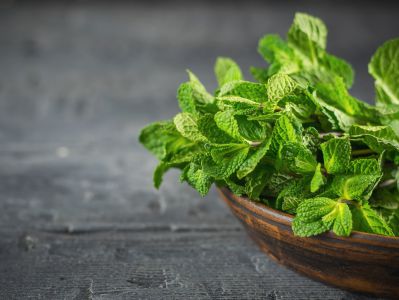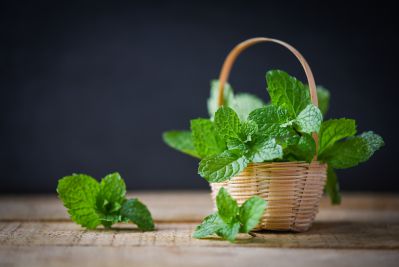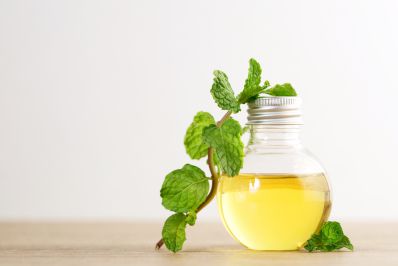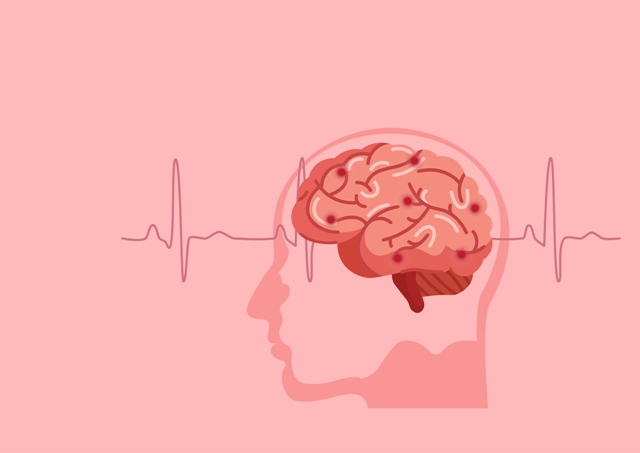Mint is an important herb belongs to Lamiaceae family. It is well known for its characteristic flavor and cooling sensation. It has been traditionally used for its countless therapeutic properties.
Characteristics
- It is a well-known aromatic compound
- It is mainly utilized as culinary herb
- It has a pungent taste along with a cooling aftertaste
- It has a sweetish odor
- Its stems are greenish to reddish in color, flowers are pinkish to reddish in color and its leaves are dark greenish to grayish green in color
Nutritional profile
- It contains carbohydrates and dietary fat
- It also contains protein
- It contains lesser amount of fat among which it is comparatively high in unsaturated fat
- The saturated fat and cholesterol contents of mint are very negligible
- It contains various vitamins like Vitamin A, vitamin C, thiamin, riboflavin, niacin, pyridoxine and folic acid
- It also contains several trace elements such as calcium, phosphorus, iron, zinc, copper, magnesium, manganese and potassium
- It is mainly packed with menthol and contains various biochemical compounds, which include cineole, menthofuran, limonene, menthyl acetate, menthone, pulegone, isomenthone, carvone and isopulegol
Health benefits
Role on gastrointestinal health

- Mint helps in digestion
- It helps to stimulate salivary gland for secreting saliva, which contains digestive enzymes (salivary amylase and salivary maltase) that help in carbohydrate digestion
- It also helps in bile secretion that promotes fat digestion
- It helps to prevent flatulence and indigestion
- Its antimicrobial activities and cooling effects are responsible for preventing irritable bowel syndrome and abdominal pain
- Menthol content of mint is accountable for protecting the lining (mucus membrane) of stomach from hydrochloric acid, ethanol and indomethacin that helps to prevent gastric ulcer formation
Role on mental health
- The smell of the essential oil of mint is responsible for refreshing the body as well as helps to relieve the stress
- The adaptogenic properties of mint leaves are accountable for controlling the action of cortisol that triggers the natural response of body to beat stress
- Inhalation of mint essential oil is associated with increasing the secretion of serotonin in brain, which helps to soothe the mind and prevents depression
- Cooling effects of mint is also related with inhibiting nervousness, tension, panic and restlessness
Role on preventing allergies
- Rosmarinic acid is an important constituent of mint which shows strong antioxidant and anti-inflammatory properties that help to reduce the prevalence of allergic reaction of body
 Role on skin
Role on skin
- Antimicrobial and cooling properties of mint help to nourish the skin and promotes skin health
- Mint is extensively used for preparing skin care products as it acts as an effective cleanser, toner and moisturizer
- Mint leaves help to prevent skin irritation by its soothing effects
- The astringent activities of mint are accountable for softening the skin and tones the skin
- Vitamin A and salicylic components of mint are responsible for controlling sebum secretion, which helps to treat acne
- The refreshing and cooling properties of mint are accountable for retaining moisture within skin that helps to tighten the skin pores
- It is also associated with slowing down the progression of ageing process
Role on hair
- Antioxidant and carotene contents of mint are responsible for promoting hair growth
- Antimicrobial activities of mint are accountable for decreasing dandruff and other scalp related issues
- It also helps to reduce hair losses
- Its menthol content is responsible for improving blood circulation to the hair follicle that synthesizes new hair cells and helps to enhances hair volume
Role on immunity
- Antimicrobial property of mint helps to reduce the susceptibility of infectious disease by preventing microbial infestation within host
- Vitamins and minerals contents of mint (especially Vitamin A, Vitamin B complex, potassium, calcium) help to increase the resistant power and strength of the body that make the body able for fighting against diseases (communicable and non-communicable)

Role on reducing pain
- The adaptogenic property and cooling effects of mint are responsible for reducing pain
- It is very effective to give relief from headache as well as migraine
- It also helps to reduce the pain of arthritis
- Inhalation of mint essential oil or its application on the painful areas is beneficial for reducing pain
Role on oral health
- Antimicrobial property of mint is responsible for preventing bacterial infestation within mouth
- Mint leaf extract helps to prevent plaque formation within teeth
- Menthol component of mint is associated with combating various dental problems
- It also helps to refresh the breath and reduces bad mouth odor
Role on brain development
- Inhalation of mint essential oil helps to promote brain functions
- Mint leaves have potent stimulant quality, which is related with improving brain health
- It helps to improve alertness and attentiveness
- It also helps to enhance cognitive abilities as well as improves memory
Ayurvedic usages

- In ayurveda mint is considered as an effective herb, which acts as natural coolant
- Mint has been traditionally used for treating gastrointestinal disorders, hypertension, stress and common colds as well as helps to boost immunity
Therapeutic usages
Role on preventing common colds
- Menthol component of mint is accountable for treating normal flu and cold
- It has potent decongestant activities, which are associated with clearing congestion of lungs, chest, throat, and nose and helps to break up mucus and phlegm
- Cooling effects of mint is responsible for relieving cough, irritated nose and sore throat
Role on preventing nipple crack during breast feeding
- It has seen that lactating mothers are very prone to develop cracked nipple during their lactation phase which leads to soreness, irritation and bleeding that make breast feeding very painful
- Mint helps to prevent the cracks of nipple by promoting rapid healing and helps to reduce the nipple pain. Application of mint extract around the nipple after every feeding is beneficial to overcome this complication
Role on preventing asthma
- Daily intake of mint leaf is very beneficial for asthmatic patients as it exerts relaxing effect and associated with preventing chest congestion
 Anti-inflammatory properties of mint also responsible for preventing congestion of lungs, throat and bronchi that help to prevent asthma and other related respiratory disorders
Anti-inflammatory properties of mint also responsible for preventing congestion of lungs, throat and bronchi that help to prevent asthma and other related respiratory disorders
Helps in weight reduction
- Mint facilitates weight reduction by boosting the metabolism
- It helps to increase the secretion of digestive enzymes (especially bile), which helps to absorb and assimilate nutrients. This feature is considered as the principal factor responsible for stimulating metabolism
Recent findings
- Green tea is a popular beverage with potent health benefits. It has strong antimicrobial and anti-carcinogenic activities that help to reduce the prevalence of cancers and microbial infestation within body. Recent research has shown that flavouring of green tea extract with mint enhances its anti-carcinogenic as well as antimicrobial activities especially against oral pathogens (Somasundaram et al., 2019)
- Current research has shown that application of aqueous and alcoholic extract of mint with symbiotic yogurt helps to enhance its sensory properties. Yogurt contains mint alcoholic extract has comparatively more desirable organoleptic characteristics than plain yogurt (Al-Shawi, 2020)
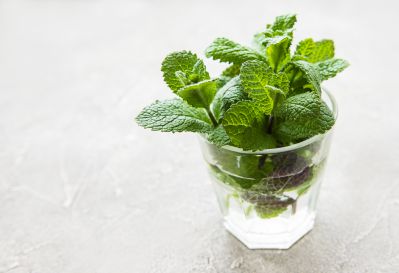
Source:
Al-Shawi, S.G., 2020. The possibility of producing synbiotic yogurt containing mint extracts. Eurasian Journal of Biosciences, 14(1), pp.2339-2345.
Bahadori, M.B., Zengin, G., Bahadori, S., Dinparast, L. and Movahhedin, N., 2018. Phenolic composition and functional properties of wild mint (Mentha longifolia var. calliantha (Stapf) Briq.). International journal of food properties, 21(1), pp.183-193.
Bolourian, M., Dadgar, H., Aqadousti, R., FiroozBakht, M., Khakpour, M., Rokni, A., Abdi, F., Ramazanian Bafghi, Z., Dabagh Fekri, S. and Ghahremani, S., 2020. The Effect of Peppermint on the Treatment of Nipple Fissure during Breastfeeding: A Systematic Review. International Journal of Pediatrics, 8(7), pp.11527-11535.
Brahmi, F., Khodir, M., Mohamed, C. and Pierre, D., 2017. Chemical composition and biological activities of Mentha species. Aromatic and medicinal plants-back to nature, pp.47-78.
Loolaie, M., Moasefi, N., Rasouli, H. and Adibi, H., 2017. Peppermint and its functionality: A review. Arch. Clin. Microbiol, 8(4), p.54.
Nayak, P., Kumar, T., Gupta, A.K. and Joshi, N.U., 2020. Peppermint a medicinal herb and treasure of health: A review. Journal of Pharmacognosy and Phytochemistry, 9(3), pp.1519-1528.
Somasundaram, R., Choraria, A., George, S.M., Narayanaswamy, K., Vasudevan, K., Antonysamy, M. and Zhang, X., 2019. A preliminary pilot scale analysis of anti-cariogenic activity of green tea powder extract flavoured with Ginger, Cloves and Mint against clinical oral pathogens. Clinical Nutrition Experimental, 24, pp.66-71.
